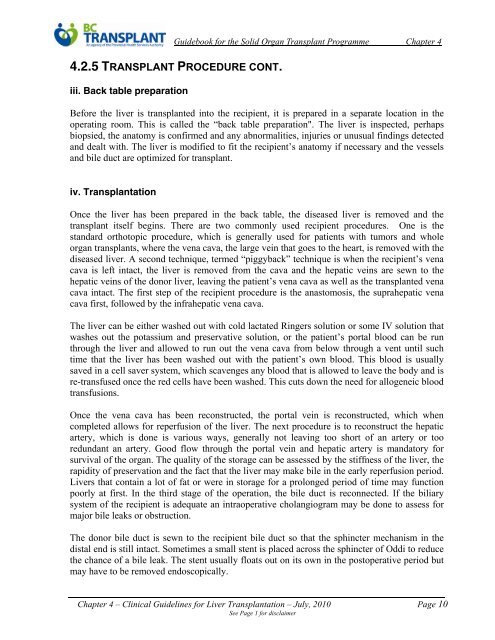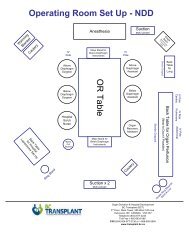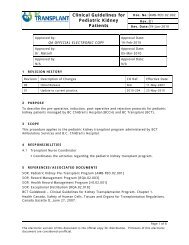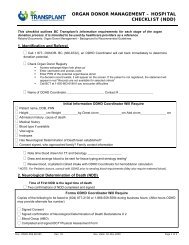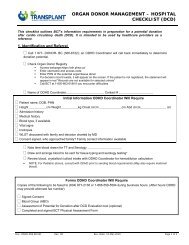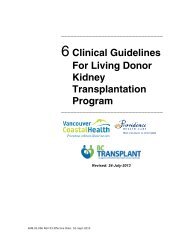4. Clinical Guidelines for Liver Transplantation (PDF) - British ...
4. Clinical Guidelines for Liver Transplantation (PDF) - British ...
4. Clinical Guidelines for Liver Transplantation (PDF) - British ...
You also want an ePaper? Increase the reach of your titles
YUMPU automatically turns print PDFs into web optimized ePapers that Google loves.
Guidebook <strong>for</strong> the Solid Organ Transplant Programme Chapter 4<br />
<strong>4.</strong>2.5 TRANSPLANT PROCEDURE CONT.<br />
iii. Back table preparation<br />
Be<strong>for</strong>e the liver is transplanted into the recipient, it is prepared in a separate location in the<br />
operating room. This is called the “back table preparation". The liver is inspected, perhaps<br />
biopsied, the anatomy is confirmed and any abnormalities, injuries or unusual findings detected<br />
and dealt with. The liver is modified to fit the recipient’s anatomy if necessary and the vessels<br />
and bile duct are optimized <strong>for</strong> transplant.<br />
iv. <strong>Transplantation</strong><br />
Once the liver has been prepared in the back table, the diseased liver is removed and the<br />
transplant itself begins. There are two commonly used recipient procedures. One is the<br />
standard orthotopic procedure, which is generally used <strong>for</strong> patients with tumors and whole<br />
organ transplants, where the vena cava, the large vein that goes to the heart, is removed with the<br />
diseased liver. A second technique, termed “piggyback” technique is when the recipient’s vena<br />
cava is left intact, the liver is removed from the cava and the hepatic veins are sewn to the<br />
hepatic veins of the donor liver, leaving the patient’s vena cava as well as the transplanted vena<br />
cava intact. The first step of the recipient procedure is the anastomosis, the suprahepatic vena<br />
cava first, followed by the infrahepatic vena cava.<br />
The liver can be either washed out with cold lactated Ringers solution or some IV solution that<br />
washes out the potassium and preservative solution, or the patient’s portal blood can be run<br />
through the liver and allowed to run out the vena cava from below through a vent until such<br />
time that the liver has been washed out with the patient’s own blood. This blood is usually<br />
saved in a cell saver system, which scavenges any blood that is allowed to leave the body and is<br />
re-transfused once the red cells have been washed. This cuts down the need <strong>for</strong> allogeneic blood<br />
transfusions.<br />
Once the vena cava has been reconstructed, the portal vein is reconstructed, which when<br />
completed allows <strong>for</strong> reperfusion of the liver. The next procedure is to reconstruct the hepatic<br />
artery, which is done is various ways, generally not leaving too short of an artery or too<br />
redundant an artery. Good flow through the portal vein and hepatic artery is mandatory <strong>for</strong><br />
survival of the organ. The quality of the storage can be assessed by the stiffness of the liver, the<br />
rapidity of preservation and the fact that the liver may make bile in the early reperfusion period.<br />
<strong>Liver</strong>s that contain a lot of fat or were in storage <strong>for</strong> a prolonged period of time may function<br />
poorly at first. In the third stage of the operation, the bile duct is reconnected. If the biliary<br />
system of the recipient is adequate an intraoperative cholangiogram may be done to assess <strong>for</strong><br />
major bile leaks or obstruction.<br />
The donor bile duct is sewn to the recipient bile duct so that the sphincter mechanism in the<br />
distal end is still intact. Sometimes a small stent is placed across the sphincter of Oddi to reduce<br />
the chance of a bile leak. The stent usually floats out on its own in the postoperative period but<br />
may have to be removed endoscopically.<br />
Chapter 4 – <strong>Clinical</strong> <strong>Guidelines</strong> <strong>for</strong> <strong>Liver</strong> <strong>Transplantation</strong> – July, 2010 Page 10<br />
See Page 1 <strong>for</strong> disclaimer


